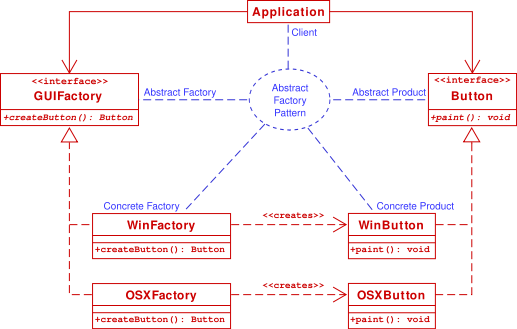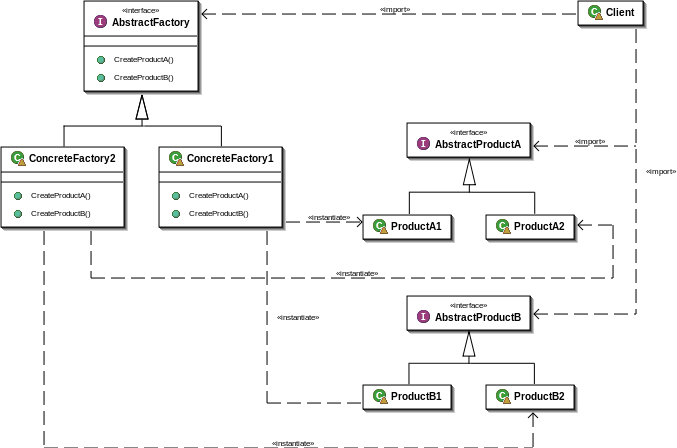CSC/ECE 517 Fall 2012/ch2b 2w57
Abstract Factory: A directory of sites
The objective of this wiki is to provide a directory of sites that one would refer to while learning about the Abstract Factory pattern. Therefore, in this wiki, we will be giving an overview of the different features of the Abstract Factory pattern along with links to useful websites that explain each of these features in more detail.
Introduction
The abstract factory pattern is a software creational design pattern that provides a way to encapsulate a group of individual factories that have a common theme without specifying their concrete classes. In normal usage, the client software creates a concrete implementation of the abstract factory and then uses the generic interfaces to create the concrete objects that are part of the theme. The client does not know (or care) which concrete objects it gets from each of these internal factories, since it uses only the generic interfaces of their products. This pattern separates the details of implementation of a set of objects from their general usage and relies on object composition, as object creation is implemented in methods exposed in the factory interface.
The essence of the Abstract Factory Pattern is to "Provide an interface for creating families of related or dependent objects without specifying their concrete classes".
Motivation
Modularization is a big issue in today's programming. Programmers all over the world are trying to avoid the idea of adding code to existing classes in order to make them support encapsulating more general information. Take the case of a information manager which manages phone number. Phone numbers have a particular rule on which they get generated depending on areas and countries. If at some point the application should be changed in order to support adding numbers form a new country, the code of the application would have to be changed and it would become more and more complicated.
In order to prevent it, the Abstract Factory design pattern is used. Using this pattern a framework is defined, which produces objects that follow a general pattern and at runtime this factory is paired with any concrete factory to produce objects that follow the pattern of a certain country. In other words, the Abstract Factory is a super-factory which creates other factories (Factory of factories).
Usage
The factory determines the actual concrete type of object to be created, and it is here that the object is actually created (in C++, for instance, by the new operator). However, the factory only returns an abstract pointer to the created concrete object. This insulates client code from object creation by having clients ask a factory object to create an object of the desired abstract type and to return an abstract pointer to the object. As the factory only returns an abstract pointer, the client code (that requested the object from the factory) does not know – and is not burdened by – the actual concrete type of the object that was just created. However, the type of a concrete object (and hence a concrete factory) is known by the abstract factory; for instance, the factory may read it from a configuration file. The client has no need to specify the type, since it has already been specified in the configuration file. In particular, this means:
- The client code has no knowledge whatsoever of the concrete type, not needing to include any header files or class declarations related to it. The client code deals only with the abstract type. Objects of a concrete type are indeed created by the factory, but the client code accesses such objects only through their abstract interface.
- Adding new concrete types is done by modifying the client code to use a different factory, a modification that is typically one line in one file. (The different factory then creates objects of a different concrete type, but still returns a pointer of the same abstract type as before – thus insulating the client code from change.) This is significantly easier than modifying the client code to instantiate a new type, which would require changing every location in the code where a new object is created (as well as making sure that all such code locations also have knowledge of the new concrete type, by including for instance a concrete class header file). If all factory objects are stored globally in a singleton object, and all client code goes through the singleton to access the proper factory for object creation, then changing factories is as easy as changing the singleton object.
Structure
Class Diagram
UML Diagram
Comparison with other patterns
Factory Pattern
The main difference between a "factory method" and an "abstract factory" is that the factory method is a single method, and an abstract factory is an object.Many people do get confused between these two terms and start using them interchangeably.The links to the sites below gives a good explanation of differences between these two terms and are easy is to follow :
http://www.codeproject.com/Articles/35789/Understanding-Factory-Method-and-Abstract-Factory
http://stackoverflow.com/questions/4209791/design-patterns-abstract-factory-vs-factory-method
Bridge Pattern
The bridge pattern is a design pattern used in software engineering which is meant to "decouple an abstraction from its implementation so that the two can vary independently". The bridge uses encapsulation, aggregation, and can use inheritance to separate responsibilities into different classes.So how does abstract factory pattern compare with this? The site given below explains the differences between abstract factory pattern and the bridge pattern in a non complicated manner:
http://stackoverflow.com/questions/7700854/abstractfactory-versus-bridge-pattern
Builder Pattern
The builder pattern is an object creation software design pattern. The intention is to abstract steps of construction of objects so that different implementations of these steps can construct different representations of objects. Often, the builder pattern is used to build products in accordance with the composite pattern.
The motivation behind the builder pattern is that the complexity of classes and objects which increases as the complexity of the application increases. Complex objects are made of parts produced by other objects that need special care when being built. An application might need a mechanism for building complex objects that is independent from the ones that make up the object.
The builder pattern allows a client object to construct a complex object by specifying only its type and content, being shielded from the details related to the object's representation. This way the construction process can be used to create different representations. The logic of this process is isolated form the actual steps used in creating the complex object, so the process can be used again to create a different object form the same set of simple objects as the first one.
The main difference between Abstract Factory and Builder is that in the case of the Abstract Factory, the client uses the factory's methods to create its own objects whereas in the Builder's case, the Builder class is instructed on how to create the object and then it is asked for it, but the way that the class is put together is up to the Builder class
The difference between Builder pattern and the Abstract Factory pattern is explained in detail in the following sites.
https://sites.google.com/site/sureshdevang/abstract-factory-vs-builder-design-patterns
http://stackoverflow.com/questions/3687299/abstract-factory-factory-method-builder
http://www.oodesign.com/builder-pattern.html
Strategy Pattern
References
- ^ [|Gamma, Erich[1]]; Richard Helm, Ralph Johnson, John M. Vlissides (2009-10-23). "Design Patterns: Abstract Factory". informIT. Archived from the original on 2009-10-23. Retrieved 2012-05-16. "Object Creational: Abstract Factory: Intent: Provide an interface for creating families of related or dependent objects without specifying their concrete classes."
- a b Freeman, Eric; Freeman, Elisabeth; Kathy, Sierra; Bert, Bates (2004). Hendrickson, Mike. ed (paperback). Head First Design Patterns. 1. O'REILLY. p. 156. ISBN 978-0-596-00712-6. Retrieved 2012-09-12.

